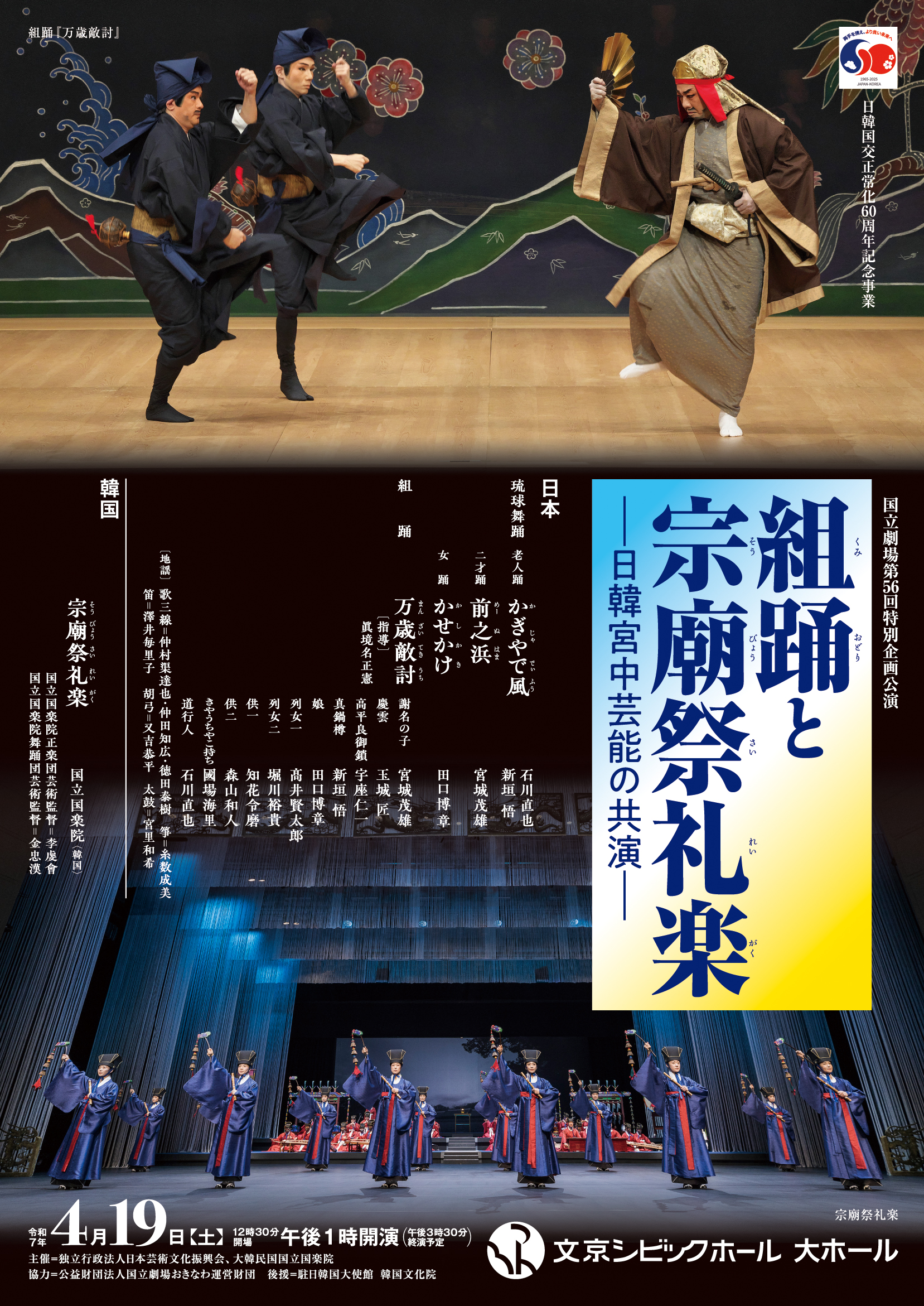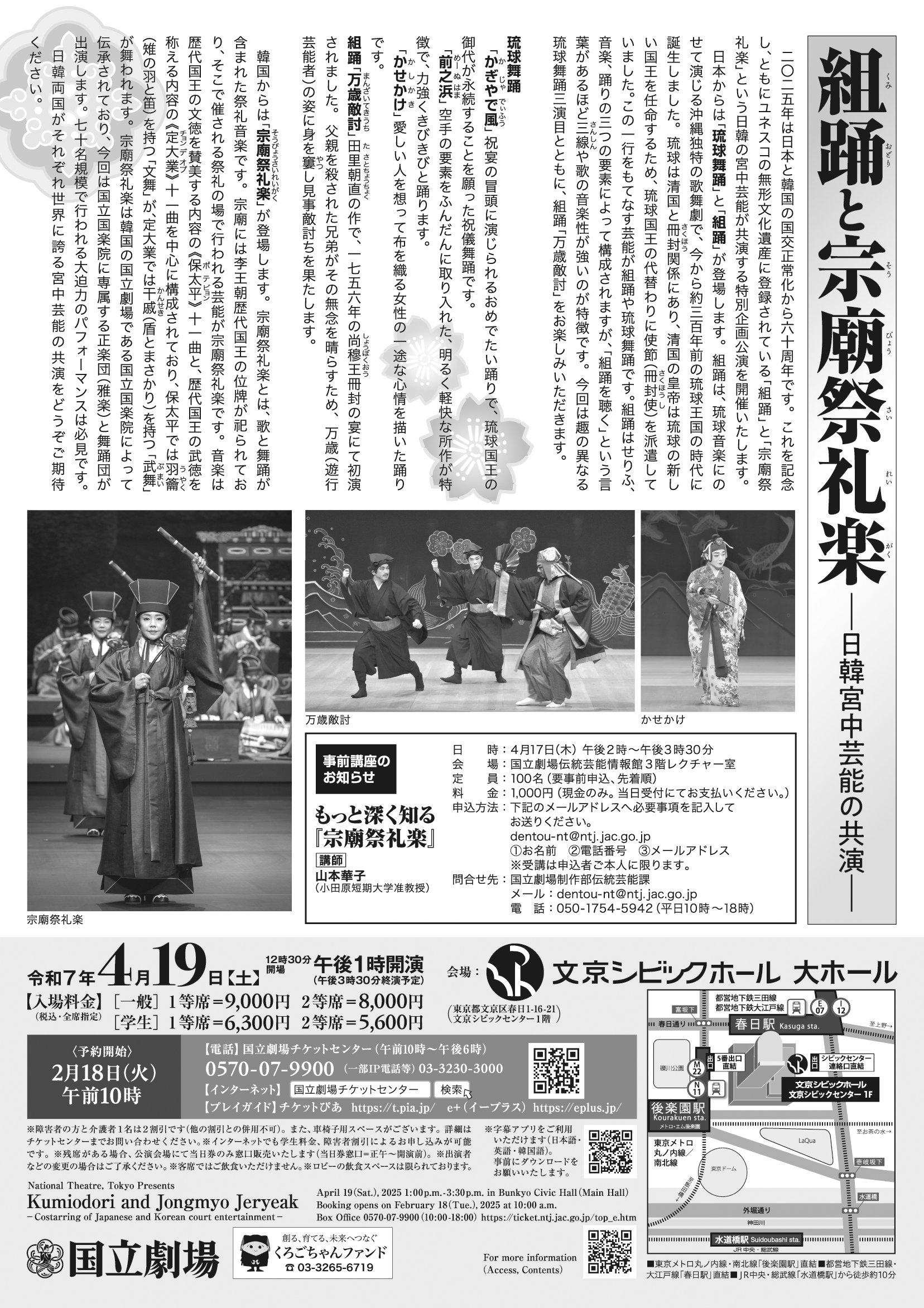- Others
- Other Theater
Kumiodori and Jongmyo Jeryeak -Costarring of Japanese and Korean court entertainment-
Bunkyo Civic Hall, Main Hall
Special Program
Kumiodori and Jongmyo Jeryeak
-Costarring of Japanese and Korean court entertainment-
Performance Date
April 19 (Sat.), 2025
Performance Time
1:00 p.m. - 3:30 p.m.
*The finish time is an estimate and may vary.
JAPAN
Ryukyuan Dance
Kajadifu
Menuhama
Kashikaki
Kumiodori
Manzai Tekiuchi
KOREA
Jongmyo Jeryeak
*Audio guide: Not available.
*Subtitles: Available in English, Korean and Japanese. Please download the application to your smartphone or tablet. How to install G-marc Subtitle application.
Tickets(Tax included)
[1st Grade] 9,000 yen (Students: 6,300 yen)
[2nd Grade] 8,000 yen (Students: 5,600 yen)
Seating plan
Booking Opens
10:00 a.m. , February 18 (Tue.) , 2025
*20% discount for audiences with disabilites and one accompanying audience.
*Tickets for students and persons with disabilities for this performance are available online.
*Wheelchair spaces are available. For more details, please contact the Box Office.
*If there are still tickets available for purchase on the day of the event, you may purchase them in person at the Box Office (on-site) for this performance.
Box Office (on-site) : Open from 12:00 p.m. until cutrain time.
-----------------------------------------------------------------------------
Box Office
0570-07-9900 (From overseas: +81-3-3230-3000) in Japanese and English
(10:00 a.m. ~ 6:00 p.m. )
Click here to find the details about how to buy tickets.
The year 2025 marks the 60th anniversary of the normalization of diplomatic relations between Japan and Korea. To commemorate this, the National Theatre presents this special program, “Costarring of Japanese and Korean court entertainment” featuring Kumiodori and Jongmyo Jeryeak, both of which are traditional performance art treasures registered as a UNESCO Intangible Cultural Heritage.
Japan presents Ryukyuan Dance and Kumiodori. Kumiodori is traditional Okinawan musical theater accompanied by Ryukyuan music, which emerged in the days of the Ryukyu Kingdom about 300 years ago. Under the tributary system of China at the time, the Emperor of the Qing Dynasty dispatched envoys called sakuhōshi to Ryukyu on the occasion of the change of the Ryukyu Kings in order to appoint a new one.
Kumiodori and Ryukyuan dances were performed to entertain these investiture envoys. Kumiodori consists of three elements ― words, music, and dance. As the expression “Kumiodori wo kiku (listening to Kumiodri)” says, it is characterized by the notable musicality of the sanshin (Ryukyuan shamisen) and songs. We invite you to enjoy this performance featuring three Ryukyuan dances of varying moods, as well as the Kumiodori play “Manzai Tekiuchi.”
Ryukyuan Dance
Kajadifu: A celebratory dance performed at the outset of a feast as a prayer for the everlasting reign of the Ryukyu kings.
Menuhama: Characterized by light, rhythmical movements generously incorporating the elements of karate, a style of dance that is very dynamic and energetic.
Kashikaki: A dance depicting the devotion of a woman as she weaves cloth while thinking about her loved one.
The Kumiodori play “Manzai Tekiuchi,” created by Tasato Chōchoku, premiered at King Shōboku’s enthronement banquet in 1756. In the play, the brothers, who are seeking revenge for the death of their father, disguise themselves as manzai performers (a pair of traveling entertainers) and eventually pull their plan off, defeating the bitter enemy.
For its part, Korea presents Jongmyo Jeryeak. Jongmyo Jeryeak is ceremonial music that includes songs and dances. Jongmyo is the place where the memorial tablets of the successive kings of the Joseon Dynasty are stored, and the entertainment performed at the rites and festivals held there is called Jongmyo Jeryeak. The music is structured on Botaepyeong (保太平), praise of the education of successive kings, and Jeongdaeeop (定大業), praise of their military exploits ― 11 pieces representing each. As for dance, Botaepyeong employs munmu (文舞; bunmai; civil dance) ― using uyaku (the feathers of pheasants and a flute), while Jeongdaeeop employs mumu (武舞; bumai; martial dance) ― using kanseki (the shield and broad-ax). Jongmyo Jeryeak has been preserved and promoted through the years by the state-run National Gugak Center. Appearing onstage for this performance are the Court Music Orchestra (Gagaku)and Dance Theater, both part of the National Gugak Center. You will not want to miss these spectacular performances featuring more than 70 extremely talented musicians and dancers!
We invite you to relax and enjoy this special performance, “Costarring of Japanese and Korean court entertainment,” in which we showcase the musical heritage and pride of each nation.


